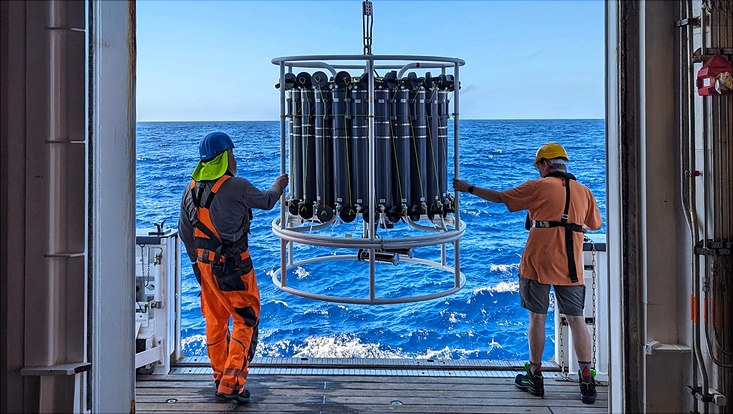Researching human-caused pollutantsResearch Ship SONNE Begins Expedition on the Indian Ocean
15 July 2024, by Anna Priebe

Photo: UHH/Yves Sorge
From 16 July to 5 August 2024, the SONNE research ship will be on an expedition in the Indian Ocean between Singapore and Mauritius. The goal is to take a closer look at little-researched pollutants such as microplastics and artificial estrogens. Three researchers from the Department of Earth System Sciences at the University of Hamburg are on board.
The current expedition is part of the Emerging Pollutants and Microplastic Abundance in Surface Waters of Indian Ocean (E-POLIO) project. Above all, researchers want to look at pollutants that have increased in the past several years. Large cities, now home to more than half of the world’s population, play an especially important role. In these metropolitan areas, the concentration of microplastics, artificial estrogens, and cancer-causing polycyclic aromatic hydrocarbons, among other things, is rising sharply. These human-caused pollutants spread, however, across vast regions and are increasingly found in marine ecosystems, where they break down only slowly.
This expedition aims to figure out how these pollutants end up in the ocean and how they spread into the various ocean layers. It is being funded by the Federal Ministry of Education and Research and headed by the Leibniz Institute for Baltic Sea Research in Warnemünde (IOW). Dr. Birgit Gaye, research associate in the Department of Earth System Sciences and the Cluster of Excellence Climate, Climatic Change, and Society (CLICCS), is also on board. Together with bachelor’s student Jonas Leonhardt and technician Marc Metzke, she will focus above all on the transport pathways of pollutants and microplastics.
Identifying water masses and understanding transport pathways
“The trip starts in a region strongly and directly impacted by humans and then crosses an ocean region very far from land that counts as one of the least studied ocean regions,” says Gaye, who works for the biochemistry research group at the Institute of Geology. “Our job will be to identify the water masses in the northern and southern hemispheres and to understand their exchange in the equatorial ocean. This will help us understand the transport paths.”
To this end, the team will take samples at different surface depths at select stations along a roughly 6,300-meter travel route. “The samples will be filtered on board to gather suspended solids, and then the water and suspended solids will be frozen for analysis at the lab back home,” explains Gaye. The stable isotopes and organic substances in the samples will allow for the identification of the water masses and their origins. The storage and decomposition of carbon and nitrogen can be reconstructed using these analyses. “Because they change radically due to the warming of the oceans, precise understanding is essential,” says Gaye.
The SONNE has 27 researchers on board
In addition to the many different water samples, air samples will also be taken on deck. Twenty-seven researchers are taking part in the expedition, which is making a recognized contribution to world-wide activities within the context of the United Nations Decade of Ocean Science. The SONNE is operated by the University of Hamburg (see information below) and this is its fourth expedition this year.
“There hasn’t been such extensive sampling in the Indian Ocean to date. In addition to assessing the environmental risk posed by the new pollutants under consideration, we also hope to make basic findings on their distribution mechanisms and where they remain, which could be used as a model for other ocean regions,” explains the Prof. Dr. Joanna Waniek, scientific director of the IOW expedition.
SONNE research ship
The University of Hamburg operates the SONNE research ship, which belongs to the Federal Republic of Germany. The German Research Fleet Coordination Centre, located at the University, is responsible for the operations of the vessels as well as for the scientific, technical, logistical, and financial organization of all expeditions. In addition to the SONNE, the University also operates the research ships METEOR and MARIA S. MERIAN.


